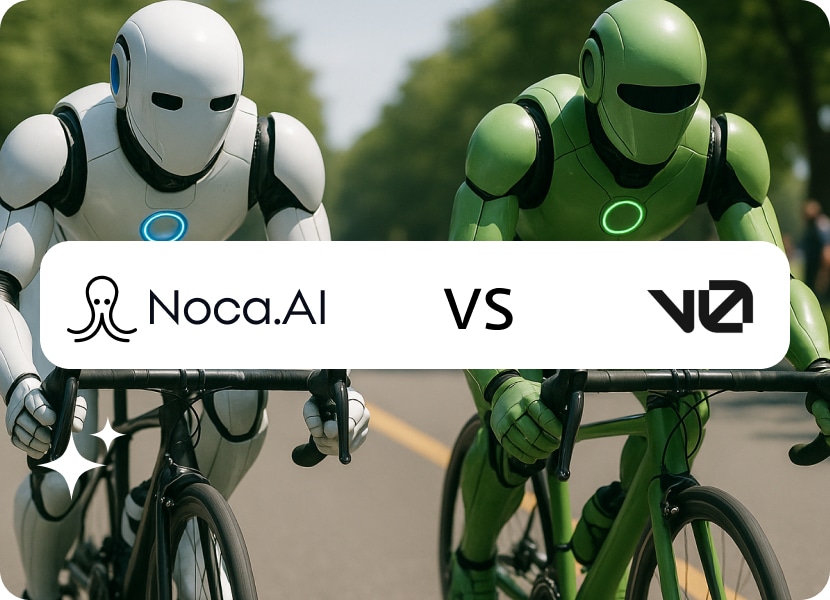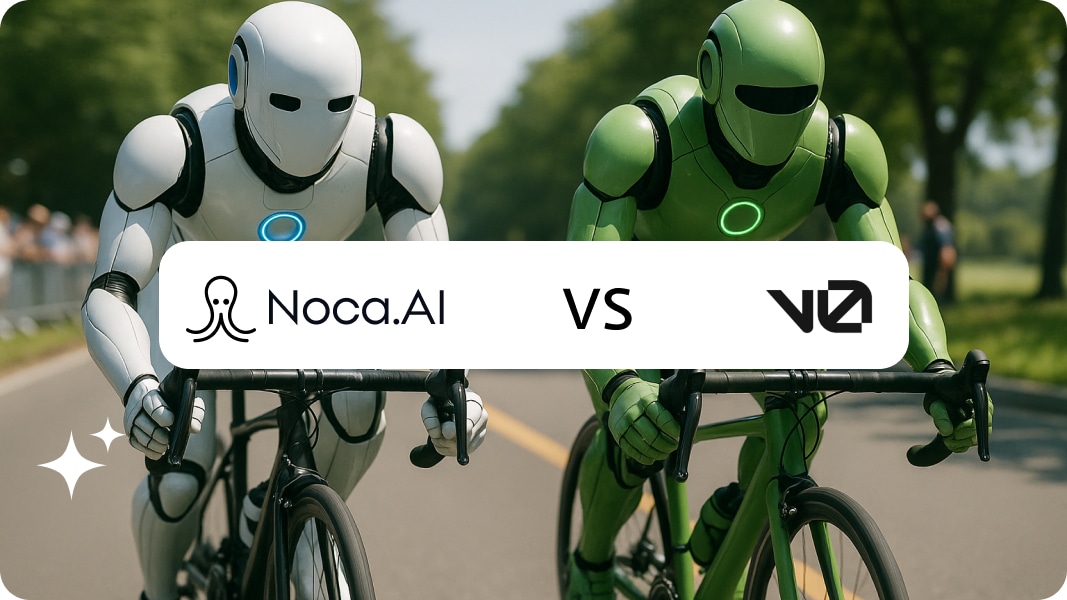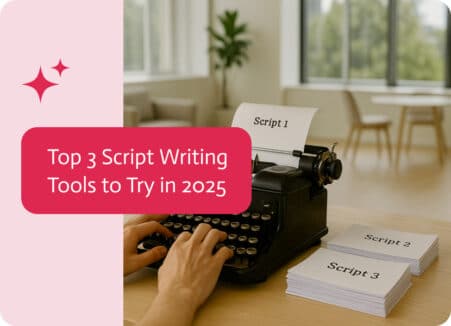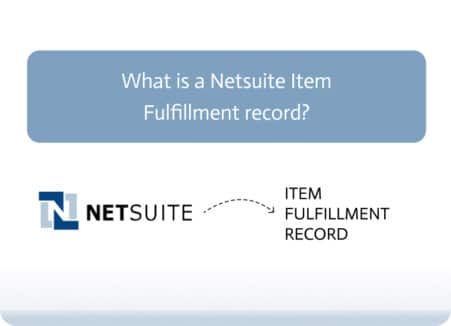

Noca vs. V0: Which Vibe Coding Platform Delivers?
So you’re wanting to put together a customized dashboard that will send Slack notifications to the appropriate teams, update your ERP when deals close, and pull data from Salesforce. Weeks of work, several developers, and most likely at least one “why isn’t this working?” moment at eleven p.m. are all part of traditional development. Imagine being able to clearly state your needs in simple terms and having a functional application available in a matter of hours rather than weeks. Vibe coding holds that promise, and as both platforms compete to realize this vision, the Noca vs. V0 debate is intensifying.
The problem is that Noca and V0 are essentially two very different approaches to vibe coding.
Vercel created V0, a front-end wizard that uses text prompts to create stunning React components. Noca is a platform for enterprise orchestration that creates full business applications with AI agents, system integrations, and backend logic. Comparing the Noca and V0 is similar to comparing a sports car and a cargo ship; both are excellent examples of vibe coding, but you wouldn’t use one to perform the other’s functions.
Let’s examine the true functions of each vibe coding platform, their strengths and weaknesses, and above all, which one you should select depending on your true goals.
Vibe Coding With V0
One vision of vibe coding is represented by V0, an AI-powered UI generator that uses natural language prompts to generate React components with Tailwind CSS. Almost instantly, V0 produces clean JSX code with Tailwind styling when you describe a dashboard layout, pricing table, or login form.
The experience of vibe coding is truly amazing. V0 creates several design variations based on the prompt you type, and you can iterate by saying things like “make the buttons larger” or “change to a dark theme.” Working with the chat interface is similar to working with a designer who understands your requests right away and produces results that are pixel-perfect.
V0’s vibe coding technique performs well when you require:
Prototyping fast: creating MVPs or mockups quickly when you need aesthetically pleasing interfaces. V0 assisted groups like Braintrust in creating their pricing page and Ingo in developing the initial iteration of their Resume Builder product.
Front-End: Developing reusable React components for your design system is known as front-end components. It creates easily accessible, editable components by integrating with Tailwind CSS and Shadcn UI.
Design-to-Code Translation: V0 converts Figma files or design mockups into functional code. The designer-to-developer handoff is significantly shortened as a result.
Vercel Ecosystem Integration: V0 fits right in if you’re already deploying on Vercel and using Next.js. Without any setup, you can deploy the generated code straight to Vercel and push it to GitHub.
Additionally, the prices are fair. V0 provides a 200-credit free tier, while its paid plans start at $10/month for 1,500 credits and go up to $50/month for 10,000 credits. A $30 per user/month plan with collaboration features is available for teams.
The Limits of V0’s Vibe Coding
Before committing to either vibe coding platform, it is important to understand what V0 won’t do in the Noca vs. V0 comparison:
No Backend Generation: V0 only concentrates on front-end programming. It won’t create a backend for you, but it can integrate with current APIs. The user interface is what you’re getting, not the database operations, server infrastructure, or business reasoning.
No Enterprise Integrations: Your ERP, NetSuite, or Salesforce systems are not connected to V0. Although you’re writing that integration layer yourself, it can create forms that will eventually POST to an API.
No Advanced Business Logic: V0 is ideal for quick, small projects, personal homepages, basic utilities, or ideas that don’t require a lot of complicated logic. V0 has trouble with requirements that go beyond simple rules.
Although still quite powerful, V0 occasionally generates huge blocks of code that require simplification or debugging and will require some manual refinement for intricate relations or accessibility compliance.
One user aptly summed up the restriction: “After five months of vibe coding, I switched back to no-code. The instability of AI-generated results was the obvious cause. Long-term maintenance was even more intimidating than debugging and fixing little errors.
V0 is brilliant at what it does, such as using vibe coding to quickly create stunning front-end components. However, it is essentially a user interface tool rather than a complete application builder. V0 is ok if your requirements only extend to the presentation layer. You will quickly run into obstacles when comparing Noca and V0 if you require real business applications.
What Noca’s Vibe Coding Does Well
Noca lets you build everything from custom CRMs and approval flows to dashboards and customer portals just through descriptions. The logic is taken care of, and it connects to your systems and generates full applications, not just simple automations.
The difference between Noca and V0 becomes clear when you look at real examples. Need a form that makes sales opportunities in Salesforce? Noca manages the user interface, Salesforce API integration, field mappings, errors, and launch.
An even more complicated option would be to create an autonomous inventory application for NetSuite that continuously scans data, keeps track of stock, initiates purchase orders, and instantly syncs inventory across several sales channels. That is a full-featured business application with logic that is very complex, numerous integrations, and independent decision-making, not a user interface element.
Where Noca vs. V0 vibe coding differs:
Enterprise Orchestration: The vibe coding turns prototypes into business results, enterprise-grade agent orchestration and system-wide automation are Noca’s primary strengths. By integrating CRMs, ERPs, and legacy systems, let teams express their goals in simple terms and then implement agentic workflows that continuously build their knowledge.
Full-Stack Generation: While front-end buttons are entertaining, servers, databases, auth sequences, and alerts are necessary. One prompt creates the entire chain with Noca’s vibe coding, connecting cloud infrastructure and keeping it simple, with relatable language.
Noca doesn’t only create static applications; it also creates AI agents. It develops them with the ability to make decisions, monitor conditions, initiate workflows, and learn patterns to improve behavior and guidance.
Native Integrations Noca integrates with your apps, files, and web services instantly, allowing you to create new workflows on top of the ones you already use. This is in contrast to something that requires you to start from scratch or find ways around restrictions.
Enterprise Security: Noca’s platform satisfies the highest requirements for security, archives, restriction of access, and complete transparency.
The Real-World Difference in Noca vs. V0
Let’s make things tangible with a scenario that shows why the Noca vs. V0 choice is imperative for your vibe coding needs:
Situation: A customer portal is necessary so that customers can make service requests, monitor the status of tickets, get updates automatically, and view account usage analytics. Your billing platform, CRM, and ticketing system must all be integrated with the portal.
Using the Vibe Coding of V0:
- Create a stunning React user interface for the portal (V0 excels at this).
- Backend built by hand or employ developers to do it.
- Integrate your CRM and ticketing system manually
- Build the notification system by hand and manually integrate it with your billing platform.
- Launch and coordinate everything by hand.
- When APIs change, manually maintain all of those integrations.
Using Vibe Coding from Noca:
- Explain every feature of the portal, including all system integrations, in simple terms.
- Examine and optimize apps that were created using conversational prompts.
- Launch into production with integrated security and control.
It’s a conversational exchange rather than a technical one. Simply tell Noca, “Actually, add a dropdown for priority level and make it required,” if you discover you’ve overlooked something. It’s finished a few seconds later. No lack of documentation. No scrounging through the configuration screens. No incessant checklists for field mapping.
When to Choose V0
The vibe coding method used by V0 makes sense in the following situations:
- You’re only creating the front end: All you need are lovely user interface elements to communicate, which is already there. V0 is very good at producing these fast.
- You’re Making Quick Prototypes: Mockup speed is more important than production readiness. Vibe coding is particularly helpful for prototyping and reworking designs with V0.
- Developer Resources Are Available to You: Your group is capable of managing deployment, integrations, and backend dev. V0 is fast for only a user interface.
- You’re in the Vercel Ecosystem: V0 integrates flawlessly if you’re already fully committed to Next.js and Vercel hosting.
- The budget is tight: V0 is available to individuals who are experimenting with vibe coding for as little as $10 per month.
When to Choose Noca
Noca’s vibe coding becomes useful when:
Fully Operational Applications: You’re not just developing UI, you’re developing complete applications, taking care of data processing, workflow automation, decision-making, and action throughout your systems.
Enterprise Integrations Cannot Be Bartered: Instead of merely making sporadic API calls, your apps must be integrated into Salesforce, NetSuite, or various other business solutions.
Development: Vibe coding should enable non-technical product managers, operations personnel, and subject matter experts to build and change anything they want without the need of an IT team.
Management and Regulation: Every app offers enterprise-grade compliance right out of the box by adhering to Noca’s TRAPS model.
AI Agents: Apps analyze conditions, learn, and act independently in accordance with business rules in addition to reacting to input.
Speed to Production Value: Noca’s vibe coding usually yields results in a matter of weeks. Teams get faster development, fewer mistakes, and fast execution. This almost instantly results in a measurable return on investment.
The Results of The Noca vs. V0
The comparison between Noca and V0 shows that these platforms aren’t actually rivals; rather, they’re addressing distinct issues for various audiences in the vibe coding market.
Which system is better at vibe coding is not the point of the Noca vs. V0 debate. The question is, what are you really trying to build?
Vibe coding’s future is represented by both mediums, albeit in different ways. V0 demonstrates how vibe coding can be used to create stunning, useful user interfaces. Noca shows how you can use smart logic and connections to orchestrate multifaceted enterprise apps using vibe coding.
When deciding between Noca and V0, consider what you need to build rather than which tool has better marketing. Likewise, if you understand vibe coding well, you may find yourself utilizing a combination, however, in all honesty, that’s not necessary when Noca can do it all.


